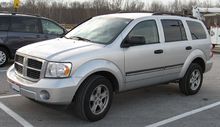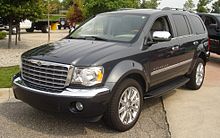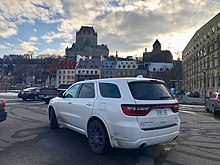Dodge Durango
| Dodge Durango | |
|---|---|
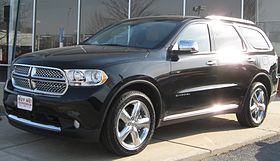 | |
| Overview | |
| Manufacturer | Chrysler Corporation (1997-1998) DaimlerChrysler (1998-2007) Chrysler LLC (2007-2009) Chrysler Group LLC (2009 and 2011-2014) FCA US LLC (2014-present) |
| Production |
|
| Body and chassis | |
| Class | Mid-size SUV |
| Layout | Front engine, rear-wheel drive / Four-wheel drive |
| Related | Jeep Grand Cherokee |
| Chronology | |
| Predecessor | Dodge Ramcharger |
The Dodge Durango is a mid-size sport utility vehicle (SUV) produced by Dodge. The first two generations were very similar in that both were based on the Dodge Dakota, both featured a body-on-frame construction and both were produced at the Newark Assembly Plant in Newark, Delaware.
The third-generation Durango is built on the same platform as the Jeep Grand Cherokee, features unibody construction, and has been assembled at the Jefferson North Assembly Plant in Detroit, Michigan, since mid-2010.
First generation (1998–2003)[edit]
| First generation | |
|---|---|
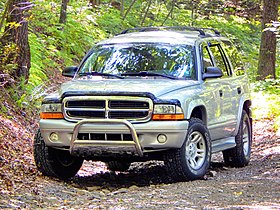 2003 Dodge Durango SLT | |
| Overview | |
| Production | 1997–2003 |
| Model years | 1998–2003 |
| Assembly | Newark, Delaware, United States |
| Designer | Dennis Myles (1995) |
| Body and chassis | |
| Platform | Chrysler DN platform |
| Related | Dodge Dakota |
| Powertrain | |
| Engine | 3.9 L (238 cu in) Magnum V6 4.7 L (287 cu in) Power Tech V8 5.2 L (318 cu in) Magnum V8 5.9 L (360 cu in) Magnum V8 |
| Transmission | 4-speed TorqueFlite automatic 4-speed RFE automatic 5-speed RFE automatic |
| Dimensions | |
| Wheelbase | 116.2 in (2,951 mm) |
| Length | 193.5 in (4,915 mm) (2001–2003) 193.3 in (4,910 mm) (1997–2000) |
| Width | 71.5 in (1,816 mm) (1997–2000) 71.3 in (1,811 mm) (2000–2003) |
| Height | 70.0 in (1,778 mm) (2001–2003) 72.9 in (1,852 mm) (1997–2000) |
| Curb weight | 4,689 lb (2,127 kg) |
The Durango was marketed as a sturdy truck-based SUV designed to hold up to seven passengers and tow up to 7,500 lb (3,400 kg) when properly equipped.[2] The Durango shared a front end, instrument panel, and front seats with the Dakota pickup on which it was based. Original designs of the eight-passenger Durango featured a rear-facing third row similar to many older station wagons. To make room for a more practical forward-facing third row, Dodge shortened the length of the front doors and raised the roof two inches (5 cm) beyond the front seats, allowing for stadium seating. The Durango's roof rack was designed to mask the appearance of the raised roof.[3]
The 4.7 L Magnum V8 replaced the 5.2 L Magnum V8 engine for 2000; however, the 5.2 was still available in the early 2000 models. In that same year, a special AWD performance version called the R/T was released with a 5.9 L Magnum V8. In 1999 and 2000, a limited-edition Shelby S.P.360 version was offered that featured a supercharged version of the 5.9 L Magnum V8 engine. Output is 360 hp (268 kW; 365 PS) and 412 lb⋅ft (559 N⋅m) of torque. Exterior modifications include unique wheels, tires, suspension, and bumpers. It came standard with Viper blue paint with two racing stripes down the center of the truck. It had a 0 to 60 mph (97 km/h) time of 7.1 seconds. The top speed was 142 mph (229 km/h).
Model year changes[edit]
For 1999, the Durango was made available with two-wheel drive. A 3.9 L Magnum V6 engine was available, but few were sold. Minor changes were made for the second year, two new paint colors and notable options available including 6-by-9-inch (150 mm × 230 mm) heated rear view mirrors and steering wheel-mounted radio controls. Leather seats became standard on SLT Plus models, and body-color wheel flares became standard on SLT Plus and four-wheel drive models.
The 2000 model year included a new 4.7 L Magnum V8 engine, which replaced the reliable 5.2 L Magnum V8, as the standard engine for four-wheel drive models. The 3.9 L Magnum V6 engine was no longer available, leaving only V8s for the rest of the production run. The high-performance Durango R/T came equipped with a performance-tuned 5.9 L Magnum V8 and all-wheel drive.
For 2001, Dodge focused on interior upgrades as Durango's interior trim panels, dash-mounted controls, instrument panel, overhead console, and steering wheel were all redesigned. The transfer case selector on 4X4 models changed from a manual lever on the console to a switch on the dash. The instrument cluster was updated, and an electronic vehicle information center was incorporated into the overhead console. For improved rear passenger comfort, a dual-zone climate-control system was added as standard equipment. Sound systems were improved on all models and now came standard with SX speakers. Other minor changes include: door panels, revised seats, aluminium wheels, and minor changes to trim options.
In 2002, the new SXT version of the Durango was offered as the entry-level trim package. Optional side curtain airbags were added for safety. The 2003 Durango featured minor mechanical changes, most notable was the addition of four-wheel disc brakes.
In 1999, the following models: 4WD 5.2L V8, 4WD 5.9L V8 hold the best crash test results in this Durango year and manufacturing, with it holding a 6.8 out of 10 total rating.
Trim levels[edit]
- 1997–2003 - SLT: Most basic trim level of the Durango from 1998-2000. Midrange trim level of the Durango from 2001-2003. SLT emblem. Included: cloth upholstery, keyless entry, power doors, locks and windows, 15" alloy rims, and an AM/FM stereo with cassette player and four speakers.
- 1997–2003 - SLT PLUS: Most luxurious trim level of the Durango from 1998-2003. Included luxury features. Based on the SLT trim level. Never featured an SLT Plus emblem, but only an SLT emblem. Added: fog lamps, floor mats for rear seat, leather upholstery, power driver's seat, security alarm, and an AM/FM stereo with single-CD and cassette players with a graphic equalizer, Infinity sound system with 8 speakers, and steering wheel audio controls.
- 2000–2003 - Sport: More basic trim level of the Durango from 2000-2003. Included basic features. Based on the SXT trim level. Sport decals.
- 2000–2003 - SXT: Most basic trim level of the Durango from 2000-2003. Included basic features. SXT decals.
- 2000–2003 - R/T: "high-performance" trim level of the Durango from 2000-2003. Included luxury and performance-oriented features. Based on the SLT Plus trim level. R/T emblems.
The SLT, SLT Plus, and Sport trim levels offered the 3.9 L Magnum V6 engine as standard equipment (late availability starting in 1999), with the 5.2 L and 5.9 L Magnum V8 engines being available options, later switching to the 4.7 L Power-Tech V8 engine, with the 5.9 L Magnum V8 engine optional. The R/T and S.P. 360 trim levels included the 5.9 L Magnum V8 engine as standard equipment.
Engines[edit]
- 1997–2000 — 5.2 L (318 cu in) Magnum V8, 230 hp (172 kW) & 300 lb⋅ft (407 N⋅m) of torque
- 1997–2000 — 3.9 L (238 cu in) Magnum V6, 175 hp (130 kW) & 225 lb·ft (305 N·m) of torque
- 1997–2003 — 5.9 L (360 cu in) Magnum V8, 245 hp (183 kW) & 330 lb·ft (449 N·m) of torque
- 1999–2000 — 5.9 L (360 cu in) Supercharged Magnum V8, 360 hp (268 kW) & 412 lb·ft (559 N·m) of torque
- 2000–2003 — 5.9 L (360 cu in) Magnum V8, 250 hp (186 kW) & 345 lb·ft (469 N·m) of torque
- 2000–2003 — 4.7 L (287 cu in) PowerTech V8, 235 hp (175 kW) & 295 lb·ft (400 N·m) of torque
Transmissions[edit]
- 42RE 4-speed TorqueFlite automatic - 3.9 L V6
- 45RFE 4-speed RFE automatic (2000–2002) - 4.7 L V8
- 545RFE 5-speed RFE automatic (2003) - 4.7 L V8
- 44RE 4-speed TorqueFlite automatic - 5.2 L V8
- 46RE 4-speed TorqueFlite automatic - 5.9 L V8
Second generation (2004–2009)[edit]
| Second generation | |
|---|---|
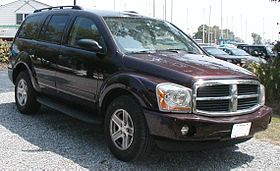 | |
| Overview | |
| Also called | Chrysler Aspen |
| Production | 2003–2008 |
| Model years | 2004–2009 |
| Assembly | United States: Newark, Delaware (Newark Assembly) |
| Body and chassis | |
| Related | Dodge Dakota |
| Powertrain | |
| Engine | |
| Electric motor | electric motors 87 hp and 235 lb.-ft (Chrysler Aspen/Dodge Durango Hybrid) |
| Transmission | |
| Dimensions | |
| Wheelbase | 119.2 in (3,028 mm) |
| Length | 200.8 in (5,100 mm) Hybrid: 202.1 in (5,133 mm) |
| Width | 76.0 in (1,930 mm) |
| Height | 74.3 in (1,887 mm) Hybrid: 73.6 in (1,869 mm) |
The second-generation Durango was first shown as a concept dubbed Dodge Durango R/T concept at the 2003 Detroit Auto Show. It debuted shortly before the companion Dakota. Like the Dakota, it has much in common with the large Dodge Ram pickup, including a fully boxed frame. It is 7 in (180 mm) longer, 2 in (51 mm) wider, and 3 in (76 mm) taller than the previous model. It also offered a third-row bench with three seats, giving it an eight-seat capacity. The design took its styling primarily from the Dodge Powerbox concept, which was itself based on the 1999 Dodge Power Wagon concept, and the 2003-2004 Durango R/T concept.
Debuting for 2004 was a new coil-spring rear suspension for the solid rear axle. A Watt's linkage system is fitted to the rear axle, centering the axle and reducing rear-end skate over rough surfaces, and allowing a lower and wider cargo floor.
Trim levels[edit]
ST (renamed SE later): 2005-2009: Most basic trim level, basic features. Included: cloth upholstery, 17" steel rims with hubcaps, antilock brakes, keyless entry, tilt steering wheel with speed control, an AM/FM stereo with single-CD player, and air conditioning. SXT added grey running boards, and an AM/FM stereo with 6-disc CD changer with MP3 capability.
SXT: 2003-2009: Most basic trim level, basic features.
SLT: 2003-2009: Value-oriented trim level, value-added features, optional luxury features. Added: premium cloth upholstery, power driver's seat, 7-passenger seating, rear air conditioning, and fog lamps. SLT G package added overhead console with compass, temperature, trip odometer, average fuel economy, and distance to empty, an AM/FM stereo with 6-disc CD changer with MP3 capability, 276 watt Infinity audio system with 8 speakers, 17" alloy rims, Sentry Key, security alarm, garage door opener, and dual sun visors.
Adventurer: 2005-2007: Value-oriented and "off-road-look" trim level, value-added features, optional luxury features. Added: V8 engine, 17" alloy rims, rear cargo organizer, and floor mats.
Limited: 2003-2009: Most luxurious trim level, luxury features. Added: leather upholstery, power adjustable pedals, auto-dimming rear view mirror, an AM/FM stereo with 6-disc CD changer with MP3 capability, a 378 watt Infinity sound-system with 8 speakers and subwoofer, memory system for driver's seat, mirrors, stereo, and pedals, automatic headlamps, automatic temp control, power mirrors, and leather-wrapped steering wheel with audio and speed controls.
All trim levels offered the 4.7L Power-Tech V8 engine as standard equipment, though the 5.7 L HEMI V8 engine was available on all trim levels, except for the base SXT trim level. The base SXT trim level also offered the 3.7 L Power-Tech V6 engine as standard equipment in place of the 5.7 L HEMI V8 engine option, though the V6 engine option was only available on the base SXT trim level, and only between 2004 and 2007.
The 2004 Dodge Durango was the first SUV in DaimlerChrysler's lineup to introduce the 5.7 L HEMI V8 engine, as well as a new radio design and modernized interior features.
Facelift[edit]
The 2007 model year featured a facelift that debuted at the Dallas Auto Show in April 2006. It featured a redesigned grille, hood, headlamps, fenders, and wheels. New features included electronic stability control, a tire pressure-monitoring system, rear park assist, and a one-touch turn signal.
In 2006, DaimlerChrysler introduced a full-size[4] luxury SUV based on the Durango, called the Chrysler Aspen, for the 2007 model year.
Engines[edit]
- 2004–2009 - 3.7 L (226 cu in) Magnum V6, 210 hp (157 kW) at 5200 rpm and 235 lb⋅ft (319 N⋅m) at 4000 rpm.
- 2004–2007 - 4.7 L (287 cu in) Magnum V8, 235 hp (175 kW) at 4500 rpm and 300 lb⋅ft (407 N⋅m) at 3600 rpm
- 2008–2009 - 4.7 L (287 cu in) Corsair V8, 303 hp (226 kW) at 5,650 rpm and 330 lb⋅ft (447 N⋅m) at 3,950 rpm
- 2004–2008 - 5.7 L (345 cu in) Hemi V8, 335 hp (250 kW) at 5200 rpm and 370 lb⋅ft (502 N⋅m) at 4200 rpm (MDS equipped for 2006+ 5.7 L engines for improved fuel mileage)
- 2009 - 5.7 L (345 cu in) Hemi V8, 376 hp (280 kW) at 5200 rpm and 401 lb⋅ft (544 N⋅m)
- 2009 Hybrid - 5.7 L (345 cu in) Hemi V8, 345 hp (257 kW) at 5200 rpm and 380 lb⋅ft (515 N⋅m), Electric Motors: 87 hp (65 kW) and 235 lb⋅ft (319 N⋅m), Combined: 390 hp (290 kW) at 5300 rpm and 499 lb⋅ft (677 N⋅m) at 2500 rpm
Chrysler Aspen[edit]
The Chrysler Aspen is a luxury SUV from Chrysler. Launched for the 2007 model-year, the Aspen was based on the Dodge Durango SUV.
The Aspen was the first truck-based SUV commercialized under the Chrysler brand, although the PT Cruiser was the first truck-based Chrysler brand vehicle as classified under Corporate Average Fuel Economy's (CAFE) regulation. With this introduction, as of 2007, all American automobile brands had an SUV in their range.[5][unreliable source?] The truck was unveiled at the 2005 North American International Auto Show. The Aspen came equipped with three rows of seating for eight passengers and available all-wheel drive.[6] It was available in only one trim, Limited.
The 2007 Chrysler Aspen appears in the 2006 movie Deck the Halls.
Due to slow sales, it was discontinued after the 2009 model year. However, the Dodge Durango Citadel covers the mid-size luxury SUV segment as of 2011.
Discontinuation[edit]
In October 2008, Chrysler announced that the shutdown of the Newark Assembly facility, which produced the Durango and the Chrysler Aspen, would be moved up to the end of 2008, thereby ending production of the Aspen and Durango after the 2009 model year.[7][8] Production ceased on December 19, 2008.
Third generation (2011–present)[edit]
| Third generation | |
|---|---|
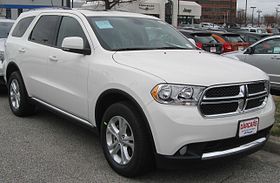 | |
| Overview | |
| Production | 2010[1]–present |
| Model years | 2011–Present |
| Assembly | Detroit, Michigan, U.S. (Jefferson North Assembly) |
| Designer | Aaron Pizzuti (2008)[9] |
| Body and chassis | |
| Related | Mercedes-Benz M-Class Mercedes-Benz R-Class Mercedes-Benz GL-Class Jeep Grand Cherokee (WK2) |
| Powertrain | |
| Engine | |
| Transmission | |
| Dimensions | |
| Wheelbase | 119.9 in (3,045 mm) |
| Length | 199.8 in (5,075 mm) |
| Width | 75.8 in (1,925 mm) |
| Height | 70.9 in (1,801 mm) |
Overview[edit]
After announcing the discontinuation of the Durango after the 2009 model year, Dodge released an Internet site and teaser photos of the third-generation Dodge Durango on August 16, 2010.
The 2011 Dodge Durango entered production on December 14, 2010,[1] alongside the second-generation Charger in the 2011 vehicle lineup. It went on sale for general dealership availability in mid-January 2011.
The third-generation Durango is built alongside the Jeep Grand Cherokee at the Jefferson North Assembly Plant in Detroit, Michigan, sharing the assembly line, running gear, powertrains, and chassis parts with the Grand Cherokee. The wheelbase of the Durango is longer than that of the Grand Cherokee. It features three rows of seating compared to the Grand Cherokee's two rows.
Trim levels[edit]
The Dodge Durango is available in several distinct trim levels:
Express - 2011 only: Base trim level, base features, 3.6 L Pentastar V6 engine only.
Crew - 2011-2013: Value-added trim level, added features, optional luxury features, 3.6 L Pentastar V6 and 5.7 L HEMI V8 engines.
SXT - 2012–present: Base trim level, base features, 3.6 L Pentastar V6 engine only.
SXT Plus - 2014–present: Basic trim level, basic features, 3.6 L Pentastar V6 engine only.
Crew Plus - 2010-2013: Luxury trim level, luxury features, 3.6 L Pentastar V6 or 5.7 L HEMI V8 engines.
Limited - 2014–2016: Luxury trim level, luxury features, 3.6 L Pentastar V6 or 5.7 L HEMI V8 engines.
GT - 2017–present: Sporty trim level that replaces the Limited trim, 3.6 L Pentastar V6 engine only.
GT Plus - 2019–present: GT trim with selected luxury amenities, 3.6 L Pentastar V6 engine only.
R/T - 2011–present: Sporty trim level, sporty details, 5.7 L HEMI V8 engine only. First return to the Dodge Durango lineup since 2001.
Citadel - 2011–present: Highest trim level, luxurious features, 3.6 L Pentastar V6 or 5.7 L HEMI V8 engines.
SRT - 2018-present: Highest performance trim level; 6.4 L HEMI V8 engine only.
A Special Service Package has also been available since 2012, and is sold exclusively to government fleets. It is based on the base Durango SXT trim level, but does offer the 5.7L HEMI V8 engine that the public-market SXT trim level does not offer.
Powertrain[edit]
The third-generation Durango features three engines. The base engine is a new 3.6 L V6 engine producing 290 hp (216 kW; 294 PS) and 260 lb⋅ft (353 N⋅m) of torque at 4,800 rpm; 90% of peak torque is available from 1,600 to 6,400 rpm. The Pentastar V6 engine is backed by a Mercedes W5A580 five-speed automatic, with Chrysler's controls and the driver-interactive control. The 5.7 L Hemi VVT V8 returned with 360 hp (268 kW; 365 PS) and 390 lb⋅ft (529 N⋅m) of torque, which features the 545RFE five-speed automatic. The Hemi V8 also comes with a "fuel-saver" (cylinder deactivation) mode. This feature is primarily used when the vehicle is cruising at constant speeds on level ground.
| Model | Engine | Displacement | Power @ rpm | Torque @ rpm | Years | Note |
|---|---|---|---|---|---|---|
| Express | 3.6 V6 Pentastar | 3,604 cc (219.9 cu in) | 290 hp (216 kW; 294 PS) @ 6400 rpm | 350 N⋅m (258 lbf⋅ft) @4800 rpm | 2011– | |
| Crew | 2010– | option 5.7 V8 HEMI | ||||
| CrewLux | 2010– | option 5.7 V8 HEMI | ||||
| Citadel | 2010– | option 5.7 V8 HEMI | ||||
| GT | 2017– | |||||
| Heat | 2010– | |||||
| R/T | 5.7 V8 HEMI | 5,654 cc (345.0 cu in) | 360 hp (268 kW; 365 PS) @ 5150 rpm | 530 N⋅m (391 lbf⋅ft) @4250 rpm | 2011– | MDS |
| SRT | 6.4 V8 HEMI | 6,417 cc (391.6 cu in) | 475 hp (354 kW; 482 PS) @ 6000 rpm | 637 N⋅m (470 lb⋅ft) @4300 rpm | 2018– |
Updates[edit]
Dodge unveiled its revised 2014 model Durango at the 2013 New York International Auto Show. The 2014 Durango was redesigned with sportier-looking lines, an eight-speed automatic transmission, and a new design trim similar to the Rallye, with blackened plastic bumper and outline. The tail lights were reworked to feature a single LED 'Racetrack' tail lamp similar to the Charger and Dart. On the inside, Dodge added a revised steering wheel, instrument cluster, rotary shift knob, and a reconfigurable 7-in (780mm) thin film transistor display first seen on the Dart.
The 2015 Durango received a new package available for the R/T trim, consisting of a Premium Nappa Leather Group option featuring radar red leather seats, 0.8-inch-lower ride height (20 mm), black headlamp bezels, HID low beams and LED DRL'S, optional R/T embroidery on the seats, a nine-speaker sound system with a subwoofer, a 360 hp (268 kW) 5.7 L Hemi paired with ZF's eight-speed transmission, and a 20-inch (510 mm) Granite Crystal wheel finished in black.[10]
For 2016 the Durango received the new Pentastar Upgrade V6 which adds Stop/Start, Variable Valve Lift and better drivability through a 15% enhanced torque curve and increasing the Variable Valve Timing from 50 degrees to 70 degrees. Other technologies include Cooled EGR and friction reduction. Despite the added tech, the engine weighs 4 lbs less. Power output remains the same at 293HP/260 ft/lbs torque (single exhaust) and 295HP/260 ft/lbs torque (dual exhaust). The Durango also added new packages to their two trims, with the Anodized Platinum package for the Citadel trim and the Brass Monkey package for the Limited trim.[11]
For 2017, the Dodge Durango Limited trim is discontinued and replaced by the new GT trim and the Base SXT trim level will now be available with three row seating fitting 7 passengers.[12]
For 2018, All models received the new Uconnect radios and the 2nd Generation ZF 8 speed automatic transmission. The rotary transmission gear shifter has been replaced with a T-grip handle like in the Dodge Charger. The steering wheel has also been changed to a more sporty wheel like found in the Dodge Charger. Other changes include suede insert leather seats and black chrome inserts in the interior on the GT model.
For 2019: The Tow Group IV package gets an integrated trailer brake controller. The Dodge Durango GT trim gets the R/T- and SRT-style grille. A new GT Plus trim is added which adds several amenities to the GT trim, such as heated front and second row seats and steering wheel; 6-way passenger power seat with 4-way lumbar adjustment; two-position memory for the driver's seat, radio, and mirrors; power lift gate; and 150W inverter.[13]
Safety[edit]
| Overall | |
| Frontal driver | |
| Frontal Passenger | |
| Side Driver | |
| Side Passenger | |
| Side Pole Driver | |
| Rollover RWD | |
| Rollover AWD |
| Small overlap front: driver side | Marginal |
| Moderate overlap front | Good |
| Side | Good |
| Roof strength | Good |
| Head restraints & seats | Good |
| Front crash prevention: vehicle-to-vehicle | Superior (2017-18 models) |
Recalls[edit]
On August 16, 2012, Chrysler recalled 1,661 2013-model Dodge Durango sport utility vehicles in the United States and Canada because some airbags may not deploy in an accident. The recall affects 1,449 of the seven-passenger versions of the SUVs in the United States and 212 in Canada and other markets.[17]
On July 24, 2015, Chrysler recalled all 2014-2015 Dodge Durangos with the 8.4-inch (210 mm) touch-screens due to security concerns with the software that controls the vehicle because it could be hacked. The vulnerability was discovered by software engineers Charlie Miller and Chris Valasek and initially posted on Wired. This vulnerability would allow hackers to remotely access and take over a variety of features, including those key parts of driving via a vulnerability in the Uconnect infotainment system.[18][19]
On November 26, 2019, Chrysler issued a recall of 700,000 2011-2013 Durangos and Jeep Grand Cherokees in the United States, Canada, and Mexico, because of an electrical failure which can cause the motor refuse to start or stop functioning while it is driving. There are no reports of accidents. The FCA group announced a free revision to both models and replacement of these pieces involved in the problem.[20]
Total sales[edit]
Dodge Durango sales[edit]
| Calendar year | US | Canada |
|---|---|---|
| 1997 | 20,263[21] | |
| 1998 | 156,923[22] | |
| 1999[23] | 189,840 | |
| 2000 | 173,567 | |
| 2001[24] | 130,799 | |
| 2002[25] | 106,925 | |
| 2003[26] | 108,010 | |
| 2004[27] | 137,148 | 6,394 |
| 2005[26] | 115,439 | 4,310 |
| 2006[28] | 70,606 | 3,836 |
| 2007[26] | 45,503 | 1,634 |
| 2008[26] | 21,420 | 1,115 |
| 2009[29] | 3,521 | 97 |
| 2010[30] | 572 | 6 |
| 2011[31] | 51,697 | 2,549 |
| 2012[32] | 42,589 | 2,398 |
| 2013 | 60,727[33] | 2,045 |
| 2014 | 64,398[34] | 2,977 |
| 2015 | 64,186[35] | 3,659 |
| 2016 | 68,474[36] | 6.266 |
| 2017 | 68,761[37] | 6,505 |
| 2018 | 65,947[38] | 6,951[39] |
| 2019 | 67,599[40] | 9,220[41] |
Chrysler Aspen sales[edit]
| Calendar Year | Sales |
|---|---|
| 2006[42] | 7,656 |
| 2007[43] | 28,788 |
| 2008[44] | 22,254 |
| 2009[45] | 5,996 |
| 2010[46] | 30 |
| Total Sales | 64,724 |
References[edit]
- ^ Jump up to: a b c "Chrysler Group LLC Celebrates Start of Production of 2011 Dodge Durango at its Jefferson North Assembly Plant". media.chrysler.com (Press release). 14 December 2010. Retrieved 2 February 2016.
- ^ "Top 10 Vehicles for Towing" Edmunds.com, retrieved on 2010-02-08. Archived August 31, 2009, at the Wayback Machine
- ^ "Developing the 1997-2003 Dodge Durango interior". Allpar.com. Retrieved 2015-07-17.
- ^ "Chrysler Aspen and Dodge Durango offer utility in a half-size smaller than their full-size competitors". caranddriver.com. Retrieved 2018-01-23.
- ^ McLane, Jenny (2005). "Chrysler Aspen Boasting the Chrysler Design". Archived from the original on October 11, 2008. Retrieved April 27, 2008.
As per the Chrysler Aspen’s introduction, all American automobile brands have a SUV under their wings.
- ^ 2008 Chrysler Aspen - Driving Dynamics - Drivetrain Archived February 23, 2009, at the Wayback Machine
- ^ "Edmunds Insideline: Chrysler Kills Durango and Aspen Hybrids". Edmunds.com. 23 October 2008. Archived from the original on 27 October 2009. Retrieved 2 February 2016.
- ^ Ramsey, Mike (2009-10-23). "Chrysler to Cut 1,825 Jobs on Early Plant Closure, Output Trim". Bloomberg. Archived from the original on 2013-12-03.
- ^ Pizzuti, Aaron. "About". Retrieved 21 October 2017.
- ^ Johnson, Davey G. (27 March 2015). "Sammy Hagar is Stoked: Dodge Now Offering Radar Red Leather on 2015 Durango R/T". Car and Driver. Retrieved 9 February 2016.
- ^ "Dodge Durango Now Available With Brass Monkey, Andonized Platinum Appearance Packages" from FCA Authority (February 17, 2016)
- ^ "Dodge Durango - Seven Seat Charger"
- ^ "2019 Dodge Durango - Compare Models"
- ^ "2018 DODGE DURANGO SUV 2WD". NHTSA. Retrieved 2019-01-22.
- ^ "2018 DODGE DURANGO SUV 4WD". NHTSA. Retrieved 2019-01-22.
- ^ "2018 Dodge Durango". IIHS. Retrieved 2019-01-22.
- ^ "Chrysler recalls 1,661 Dodge SUVs for airbag issue". Reuters. Retrieved 2 February 2016.
- ^ "Chrysler recalls 1.4 million hackable cars". CNN Money. Retrieved 2015-07-24.
- ^ "Jeep, Dodge, Chrysler maker recalls 1.4 million vehicles amid car hacking fears". Digital Trends. Retrieved 2015-07-24.
- ^ https://automexico.com/industria/jeep-grand-cherokee-y-dodge-durango-son-llamadas-a-revision-aid6038
- ^ "Record Sales Year for DaimlerChrysler's Dodge, Jeep, Chrysler And Plymouth Brands". theautochannel.com.
- ^ "1998 Sales of SUVs". wagoneers.com. Archived from the original on 2001-06-01.
This information from the September 1999 issue of Four Wheeler magazine, page 18.
- ^ "Chrysler Group Announces Year-End and December Sales". Theautochannel.com. Retrieved 2009-04-28.
- ^ "Chrysler Group Reports U.S. December Sales". Theautochannel.com. Retrieved 2009-04-28.
- ^ "Chrysler Group Reports December 2003 Sales Increase of 2 Percent". Theautochannel.com. November 17, 2004. Retrieved 2009-04-28.
- ^ Jump up to: a b c d "Dodge Durango Sales Figures". goodcarbadcar.net. January 1, 2011. Retrieved 2014-11-12.
- ^ "Chrysler Group 2005 U.S. Sales Rise 5 Percent, Highest Since 2000; December Sales Decline In Line with Overall Industry". Prnewswire.com. Archived from the original on June 5, 2009. Retrieved 2009-04-28.
- ^ "Total Chrysler LLC December 2007 Sales Up 1 Percent on the Strength of Retail; Demand..." Reuters. January 3, 2008. Archived from the original on February 3, 2009. Retrieved 2009-04-28.
- ^ "Chrysler Group LLC Reports December 2009 U.S. Sales". www.CheersandGears.com. Retrieved 2010-01-05.
- ^ "Chrysler Group LLC Reports December 2010 U.S. Sales". www.CheersandGears.com. Retrieved 2011-01-04.
- ^ "Chrysler sales shoot up 37% (26% for 2011)". allpar.com. Archived from the original on 2012-01-10. Retrieved 2012-01-04.
- ^ "Chrysler Group LLC Reports December 2012 U.S. Sales Increased 10 Percent" (Press release). Chrysler Group LLC. 3 January 2013. Retrieved 2 February 2016.
- ^ "Chrysler Group LLC Reports December 2013 U.S. Sales Increased 6 Percent – Best December Sales in Six Years; Full-Year Sales Up 9 Percent – Strongest Annual Sales Since 2007" (Press release). Chrysler Group. 3 January 2014. Retrieved 2 February 2016.
- ^ FCA US (5 January 2015). "FCA US LLC Reports December 2014 U.S. Sales Increased 20 Percent..." prnewswire.com. Retrieved 2 February 2016.
- ^ "Dodge Durango Sales Figures". www.goodcarbadcar.net. Retrieved 2016-02-09.
- ^ "Dodge Durango Sales Numbers, Figures, Results". Fiat Chrysler Authority. Retrieved 2017-01-03.
- ^ Good Car Bad Car (dodge-durango-sales-figures)
- ^ http://media.fcanorthamerica.com/newsrelease.do?id=20509&mid=1
- ^ http://media.fcanorthamerica.com/newsrelease.do?id=20510&mid=1
- ^ https://media.fcanorthamerica.com/newsrelease.do?id=21465&mid=425
- ^ https://media.fcanorthamerica.com/newsrelease.do?id=21467&mid=425
- ^ "Chrysler Aspen Sales Figures". goodcarbadcar.net. April 29, 2013. Retrieved 2014-11-12.
- ^ "Total Chrysler LLC December 2007 Sales Up 1 Percent on the Strength of Retail". CheersandGears.com. January 3, 2008. Retrieved 2009-01-05.
- ^ "December 2008 Sales: Chrysler LLC". CheersandGears.com. January 5, 2009. Retrieved 2009-01-05.
- ^ "Chrysler Group LLC December 2009 Sales". CheersandGears.com. January 5, 2010. Retrieved 2010-01-05.
- ^ "Chrysler Sales End The Year Up 17% - December Sales Rose 16%". Autospies.com. Retrieved 3 February 2016.
External links[edit]
| Wikimedia Commons has media related to Dodge Durango. |
| show Dodge truck timeline, North American market, 1970s–present
|
|---|
| show « previous — Chrysler car timeline, 1970–present
|
|---|
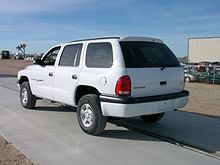
.jpg)
